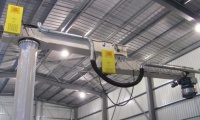Difference between revisions of "Articulated Loading Systems"
Jump to navigation
Jump to search
PurplePen19 (talk | contribs) |
PurplePen19 (talk | contribs) |
||
| Line 1: | Line 1: | ||
[[Category: Loading and Unloading Equipment]]{{Knoppen}} | [[Category: Loading and Unloading Equipment]]{{Knoppen}} | ||
[[File:Articulated Loading Systems_1.jpg|thumb|200px|right|Articulated Loading Systems]] | [[File:Articulated Loading Systems_1.jpg|thumb|200px|right|Articulated Loading Systems]] | ||
Latest revision as of 05:30, 12 September 2013
In an articulated loading system, there were two conveying arms with powered pivot joints allow the loader to extend up to 12 meters and rotate up to 330 degrees. This makes it easy to precisely position the loader discharge over each section or inlet hatch of the truck or railcar, without moving the vehicle. Pendant controls are then used to position the load-out spout and start the conveying process. 500 cubic meters /hour loading rates are typical for this equipment but rates as high as 850 cubic meters per hour are possible. Moreover, articulated loading systems are used to load materials like fertilizer, alumina, soy meal, plastic pellets, catalysts and calcium carbonate at rates up to 850 cubic meters per hour.
Videos
